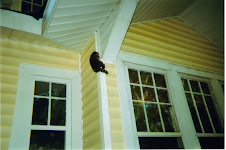I have enjoyed this urban farming idea very much since the inception of turning some flower beds into more of a self producing plot of city lot. HA, you scoff...farm indeed! Well, MY urban farm anyway. I have a vegetable garden, flower garden(s), raise chickens to feed myself and others...so YES I SAY...FARM! URBAN FARM! Farm definition: "FARM: A tract of land devoted to the production of agricultural products and the raising and breeding of domestic animals". I rest my case from this point on for you scoffers and naysayers out there.
The pullets started this week on their new rations of oyster shell and layer crumbles, along with grit for digestion, to prepare the way for egg production for the early maturing birds. I have some breeds that do have moderately early maturing times...Speckled Sussex, the Wyandottes (both Silver Laced & Golden Laced), Ameraucanas (the tinted blue & green egg layers), Black Austraulorps, Buff Orpingtons, and the Barred Rocks which are rather early maturing birds. The earliest eggs could be as soon as the next week or two from some of these. The 2-Black Jersey Giants I have are very slow to mature due to their huge size, being the largest of the domesticated chickens for layers. They do not have a good feed-to-egg conversion but I got them mainly for a conversation piece...they are really large already and if they top out like I think, they will be a head at least about the crowd for sure! Then there are the the 3-Cuckoo Marans...the chocolate egg layers. I have found that even though the name "cuckoo" is supposed to represent the color pattern (similar to the Barred Rocks but more disorganized white stripes on black background) the name really represents the character and temperament, as they are a little cuckoo if you ask me. They truly run around like "a chicken with their heads cut off" if you excuse the quote. Quite the little clowns they are.
I leave you today then with our ongoing gardening affirmation in mind: "URBAN FARMING: ONE EGG AT A TIME!"



















Looks like a farm to me!
ReplyDeleteDoes your feed have antibiotics in it or anything that would prevent your eggs from being called "organic." What is the alternative to commercial feed if you wanted to be completely "home grown"?
Sid
For SID: No antibiotics OR steroids...this urban farm is ANTI-antibiotics and steroids for this hens-in-training! All natural diet, including their feed, which was previously grower feed and as of last week now on layer crumbles - drug free. So yes if I were in the egg business I could eventually get "certified organic". But having all my feed home grown will have to wait for the "mini-farm".
ReplyDeleteThanks for following Garden Daddy!
Follow up on the comments above--what's in 'Feeder Mash' that makes it so good for layers if not 'inorganic' stuff? Just wondering. Thanks.
ReplyDeleteCharlie, Are you asking about "laying mash" or "grower feed"? I understand there are some binders in the crumbles but mostly vegetable protien. I think using the layer CRUMBLES is better than pellets as the pellets are larger and they are forced to use more "binder" to make then into the form fo the pellets. It might not be "organically grown" vegetable protien but still vegetable protein. I believe from what I know that with the layer CRUMBLES being around 16-18% protein and then adding some scratch feed (a mixed cracked corn and other seed-type mixture) daily as additional ground feeding supplement along with the grasses and other bugs, worms, etc the chickens can scrounge up that some kind of balance occurs. I am not familiar with "feeder mash" per se. Hope this helps.
ReplyDelete